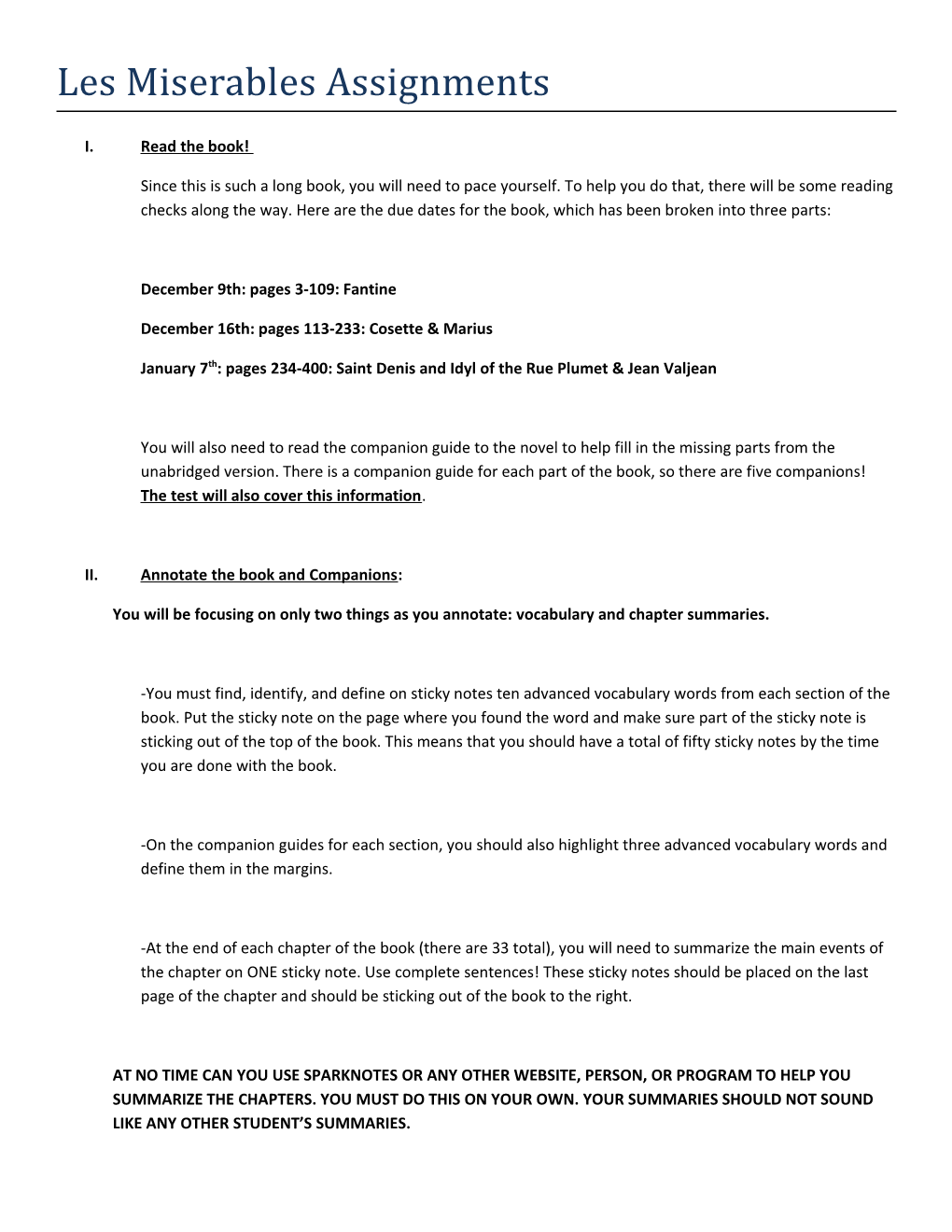Les Miserables Assignments
- Read the book!
Since this is such a long book, you will need to pace yourself. To help you do that, there will be some reading checks along the way. Here are the due dates for the book, which has been broken into three parts:
December 9th: pages 3-109: Fantine
December 16th: pages 113-233: Cosette & Marius
January 7th: pages 234-400: Saint Denis and Idyl of the Rue Plumet & Jean Valjean
You will also need to read the companion guide to the novel to help fill in the missing parts from the unabridged version. There is a companion guide for each part of the book, so there are five companions! The test will also cover this information.
- Annotate the book and Companions:
You will be focusing on only two things as you annotate: vocabulary and chapter summaries.
-You must find, identify, and define on sticky notes ten advanced vocabulary words from each section of the book. Put the sticky note on the page where you found the word and make sure part of the sticky note is sticking out of the top of the book. This means that you should have a total of fifty sticky notes by the time you are done with the book.
-On the companion guides for each section, you should also highlight three advanced vocabulary words and define them in the margins.
-At the end of each chapter of the book (there are 33 total), you will need to summarize the main events of the chapter on ONE sticky note. Use complete sentences! These sticky notes should be placed on the last page of the chapter and should be sticking out of the book to the right.
AT NO TIME CAN YOU USE SPARKNOTES OR ANY OTHER WEBSITE, PERSON, OR PROGRAM TO HELP YOU SUMMARIZE THE CHAPTERS. YOU MUST DO THIS ON YOUR OWN. YOUR SUMMARIES SHOULD NOT SOUND LIKE ANY OTHER STUDENT’S SUMMARIES.
There will be three checks on the annotations on the dates above. You will need to make sure that you have annotated the part(s) of the book and companion guides that are due on the above dates. The book is divided into five parts, with each part named, as you can see below:
pages 3-109: Fantine
pages 113-149: Cosette
pages 153-233: Marius
pages 237-301: Saint Denis and Idly of the Rue Plumet
pages 305-400: Jean Valjean
- Complete a constructed response for each due date:
- For each of the due dates, you must type the answer to the following constructed response prompts.
- You must type it in MLA format, Times New Roman 12 font, double-spaced, one-inch margins.
- Type the question in bold and then type your answer, using multiple examples from the text to support your point.
- The response must not be longer than one paragraph and cannot be longer than one page typed in the specified format above. Use the format for constructed responses that we have already learned:
- Topic sentence: Reword the prompt and address the main idea of the answer you will give.
- Give a specific example from the text.
- Explain what that specific example from the text has to do with the question of the prompt.
- Give another specific example from the text.
- Explain again. Repeat with other examples you give.
- Final sentence: Summarize the paragraph by summarizing your answer to the question.
- DO NOT USE FIRST OR SECOND PERSON IN YOUR CONSTRUCTED RESPONSE.
- Give page numbers in parenthesis to document where you found your specific examples from the text.
- It must be printed out and brought to class on the above due dates for each part of the book. You must also upload it in Turnitin.com, or it won’t be graded.
December 9th: pages 3-109: Fantine
Constructed Response: Using many specific examples from Part I: Fantine of Les Miserables, explain how the character of Jean Valjean is developed by Victor Hugo.
December 16th: pages 113-233: Cosette & Marius
Constructed Response: Using many specific examples from Parts II and III of Les Miserables, explain how Victor Hugo uses figurative language (such as similes, metaphors, personification, etc.) effectively.
January 7th: pages 234-400: Saint Denis and Idyl of the Rue Plumet & Jean Valjean
Constructed Response: Using many specific examples from Parts IV and V of Les Miserables, explain how the author’s purpose (to entertain, inform, persuade, narrate, instruct, etc.) is revealed through a theme or main idea (love, honor, revolution, justice, etc.) in the novel.
